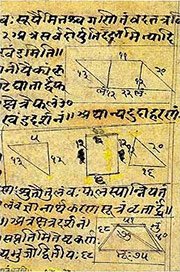Sayaka, Sāyaka, Shayaka, Śāyaka: 17 definitions
Introduction:
Sayaka means something in Hinduism, Sanskrit, Buddhism, Pali, the history of ancient India, Marathi, Hindi. If you want to know the exact meaning, history, etymology or English translation of this term then check out the descriptions on this page. Add your comment or reference to a book if you want to contribute to this summary article.
The Sanskrit term Śāyaka can be transliterated into English as Sayaka or Shayaka, using the IAST transliteration scheme (?).
Alternative spellings of this word include Shayak.
In Hinduism
Dhanurveda (science of warfare)
Source: Wisdom Library: DhanurvedaSāyaka (सायक) refers to a kind of weapon (a missile or arrow). It is a Sanskrit word defined in the Dhanurveda-saṃhitā, which contains a list of no less than 117 weapons. The Dhanurveda-saṃhitā is said to have been composed by the sage Vasiṣṭha, who in turn transmitted it trough a tradition of sages, which can eventually be traced to Śiva and Brahmā.

Dhanurveda (धनुर्वेद) refers to the “knowledge of warfare” and, as an upaveda, is associated with the Ṛgveda. It contains instructions on warfare, archery and ancient Indian martial arts, dating back to the 2nd-3rd millennium BCE.
Jyotisha (astronomy and astrology)
Source: Wikibooks (hi): Sanskrit Technical TermsSāyaka (सायक).—1. Arrow. 2. Height of an arc or segment of a circle. Note: Sāyaka is a Sanskrit technical term used in ancient Indian sciences such as Astronomy, Mathematics and Geometry.

Jyotisha (ज्योतिष, jyotiṣa or jyotish) refers to ‘astronomy’ or “Vedic astrology” and represents the fifth of the six Vedangas (additional sciences to be studied along with the Vedas). Jyotisha concerns itself with the study and prediction of the movements of celestial bodies, in order to calculate the auspicious time for rituals and ceremonies.
Kavya (poetry)
Source: Brill: Śaivism and the Tantric Traditions (kavya)Sāyaka (सायक) refers to “arrows”, according to the Kālidāsa’s Raghuvaṃśa.—Accordingly, “The mantras of Vasiṣṭha, the Guru, and the arrows (sāyaka) of that archer—what is there to achieve that these two could not achieve when united?”.

Kavya (काव्य, kavya) refers to Sanskrit poetry, a popular ancient Indian tradition of literature. There have been many Sanskrit poets over the ages, hailing from ancient India and beyond. This topic includes mahakavya, or ‘epic poetry’ and natya, or ‘dramatic poetry’.
Ganitashastra (Mathematics and Algebra)
Source: archive.org: Hindu MathematicsSāyaka (सायक) represents the number 5 (five) in the “word-numeral system” (bhūtasaṃkhyā), which was used in Sanskrit texts dealing with astronomy, mathematics, metrics, as well as in the dates of inscriptions and manuscripts in ancient Indian literature.—A system of expressing numbers by means of words arranged as in the place-value notation was developed and perfected in India in the early centuries of the Christian era. In this system the numerals [e.g., 5—sāyaka] are expressed by names of things, beings or concepts, which, naturally or in accordance with the teaching of the Śāstras, connote numbers.

Ganitashastra (शिल्पशास्त्र, gaṇitaśāstra) refers to the ancient Indian science of mathematics, algebra, number theory, arithmetic, etc. Closely allied with astronomy, both were commonly taught and studied in universities, even since the 1st millennium BCE. Ganita-shastra also includes ritualistic math-books such as the Shulba-sutras.
India history and geography
Source: Cologne Digital Sanskrit Dictionaries: Indian Epigraphical GlossarySāyaka.—(IE 7-1-2), ‘five’. Note: sāyaka is defined in the “Indian epigraphical glossary” as it can be found on ancient inscriptions commonly written in Sanskrit, Prakrit or Dravidian languages.

The history of India traces the identification of countries, villages, towns and other regions of India, as well as mythology, zoology, royal dynasties, rulers, tribes, local festivities and traditions and regional languages. Ancient India enjoyed religious freedom and encourages the path of Dharma, a concept common to Buddhism, Hinduism, and Jainism.
Languages of India and abroad
Pali-English dictionary
Source: BuddhaSasana: Concise Pali-English Dictionarysāyaka : (adj.) one who tastes.

Pali is the language of the Tipiṭaka, which is the sacred canon of Theravāda Buddhism and contains much of the Buddha’s speech. Closeley related to Sanskrit, both languages are used interchangeably between religions.
Marathi-English dictionary
Source: DDSA: The Aryabhusan school dictionary, Marathi-Englishsāyaka (सायक).—m An arrow.
Marathi is an Indo-European language having over 70 million native speakers people in (predominantly) Maharashtra India. Marathi, like many other Indo-Aryan languages, evolved from early forms of Prakrit, which itself is a subset of Sanskrit, one of the most ancient languages of the world.
Sanskrit dictionary
Source: DDSA: The practical Sanskrit-English dictionaryŚāyaka (शायक).—
1) An arrow.
2) A sword; cf. सायक (sāyaka).
Derivable forms: śāyakaḥ (शायकः).
--- OR ---
Sāyaka (सायक).—[so-ṇvul]
1) An arrow; तत् साधुकृतसंधानं प्रतिसंहर सायकम् (tat sādhukṛtasaṃdhānaṃ pratisaṃhara sāyakam) Ś.1.11.
2) A sword.
3) The number 'five'
4) The latitude of the sky.
Derivable forms: sāyakaḥ (सायकः).
Source: Cologne Digital Sanskrit Dictionaries: Shabda-Sagara Sanskrit-English DictionaryŚāyaka (शायक).—m.
(-kaḥ) 1. An arrow. 2. A sword. E. śī to destroy, ṇvul aff.; also sāyaka .
--- OR ---
Sāyaka (सायक).—m.
(-kaḥ) 1. An arrow. 2. A sword. f.
(-yikā) Standing in order. E. ṣo to destroy, ṇvul aff.
Source: Cologne Digital Sanskrit Dictionaries: Benfey Sanskrit-English DictionaryŚāyaka (शायक).—see sāyaka.
--- OR ---
Sāyaka (सायक).—[sāya + ka] (and śāyaka śāyaka), m. 1. An arrow, [Pañcatantra] 120, 10. 2. A sword.
Source: Cologne Digital Sanskrit Dictionaries: Cappeller Sanskrit-English DictionaryŚāyaka (शायक).—[feminine] yikā = [preceding]; *[feminine] also mode of lying or one’s turn to lie.
--- OR ---
Sāyaka (सायक).—[adjective] suitable for hurling; [masculine] [neuter] missile, arrow.
Source: Cologne Digital Sanskrit Dictionaries: Monier-Williams Sanskrit-English Dictionary1) Śāyaka (शायक):—[from śāya] mf(ikā)n. idem, [Viṣṇu-smṛti, viṣṇu-sūtra, vaiṣṇava-dharma-śāstra] (cf. kośa-, vṛkṣa-śāyikā)
2) [from śāya] [wrong reading] for sāyaka, arrow.
3) Sāyaka (सायक):—[from sāya] mfn. intended or fitted to be discharged or hurled, [Ṛg-veda] ([Naighaṇṭuka, commented on by Yāska ii, 20])
4) [v.s. ...] m. (in, [Ṛg-veda] also n.) a missile, arrow, [Ṛg-veda] etc. etc.
5) [v.s. ...] m. a symbolical expression for the number ‘five’ (from the 5 arrows of the god of love), [Sāhitya-darpaṇa]
6) [v.s. ...] a sword, [Mahābhārata; Rāmāyaṇa]
7) [v.s. ...] the latitude of the sky, [Gaṇitādhyāya]
8) [v.s. ...] Saccharum Sara, [cf. Lexicographers, esp. such as amarasiṃha, halāyudha, hemacandra, etc.]
9) [v.s. ...] Name of a man, [Pravara texts]
Source: Cologne Digital Sanskrit Dictionaries: Yates Sanskrit-English Dictionary1) Śāyaka (शायक):—(kaḥ) 1. m. An arrow, sword.
2) Sāyaka (सायक):—(kaḥ) 1. m. An arrow; sword. f. yikā Standing in order.
Source: DDSA: Paia-sadda-mahannavo; a comprehensive Prakrit Hindi dictionary (S)Sāyaka (सायक) in the Sanskrit language is related to the Prakrit word: Sāyaga.
[Sanskrit to German]
Sanskrit, also spelled संस्कृतम् (saṃskṛtam), is an ancient language of India commonly seen as the grandmother of the Indo-European language family (even English!). Closely allied with Prakrit and Pali, Sanskrit is more exhaustive in both grammar and terms and has the most extensive collection of literature in the world, greatly surpassing its sister-languages Greek and Latin.
Hindi dictionary
Source: DDSA: A practical Hindi-English dictionary1) Śāyaka (शायक) [Also spelled shayak]:—(nm) an arrow.
2) Sāyaka (सायक):—(nm) an arrow.
...
Kannada-English dictionary
Source: Alar: Kannada-English corpusSāyaka (ಸಾಯಕ):—[noun] he who helps.
--- OR ---
Sāyaka (ಸಾಯಕ):—
1) [noun] a slender, straight missile pointed at one end and feathered at the other, shot from bows; an arrow.
2) [noun] a slightly curved, hand-weapon, with a long cutting edge on one side and a pointed end; a sword.
Kannada is a Dravidian language (as opposed to the Indo-European language family) mainly spoken in the southwestern region of India.
See also (Relevant definitions)
Starts with: Cayakam, Cayakantai, Cayakanti, Cayakaulam, Sayakada, Sayakadale, Sayakadaum, Sayakam, Sayakamaya, Sayakapranutta, Sayakapunkha, Sayakaravat, Sayakaya, Sayakayana, Sayakayani, Sayakayanin.
Ends with (+17): Adhyavasayaka, Ahisayaka, Apurvasayaka, Asamasayaka, Asanvasayaka, Astrasayaka, Avasayaka, Bhishayaka, Bishayaka, Caruvishayaka, Harimanyusayaka, Kashayaka, Khetasayaka, Kimvishayaka, Kinkinisayaka, Kshayaka, Kusumasayaka, Lohitakshayaka, Navashayaka, Nitivishayaka.
Full-text (+28): Navashayaka, Sayakamaya, Sayaga, Astrasayaka, Pushpasayaka, Sayakam, Sayakapunkha, Asamasayaka, Sayakayana, Sayakapranutta, Sayika, Avasayaka, Cayakam, Shayak, Smarasayakalakshyata, Pancasayaka, Kusumasayaka, Vaksayaka, Prabhedana, Kinkinisayaka.
Relevant text
Search found 13 books and stories containing Sayaka, Sāyaka, Shayaka, Śāyaka; (plurals include: Sayakas, Sāyakas, Shayakas, Śāyakas). You can also click to the full overview containing English textual excerpts. Below are direct links for the most relevant articles:
Rig Veda (translation and commentary) (by H. H. Wilson)
Kamashastra Discourse (Life in Ancient India) (by Nidheesh Kannan B.)
2. Works on Kāmaśāstra (b): Pañcasāyaka < [Chapter 2 - An Appraisal of Kāmaśāstra Works in Sanskrit]
8.3. The Body in Kāmaśāstra < [Chapter 5 - Looking for Alternatives: Possibilities in Kāmaśāstra]
Sahitya-kaumudi by Baladeva Vidyabhushana (by Gaurapada Dāsa)
Text 7.135 < [Chapter 7 - Literary Faults]
Vakyapadiya of Bhartrihari (by K. A. Subramania Iyer)
Verse 3.14.441 < [Book 3 - Pada-kāṇḍa (14): Vṛtti-samuddeśa (On Ccomplex Formation)]
Asoka Chakra < [March 1950]
Satirical works of Kshemendra (study) (by Arpana Devi)
7.4. Summary of the Pādatāḍitaka < [Chapter 1 - Introduction]